Alan Cathcart | December 7, 2017
INTERVIEW
If you’re a fan of flat track racing, then you’re a fan of Michael Lock, at least you should be. After all, he is the man who figured out how to breathe new life into a sport that many said, just a few years ago, was dying and couldn’t be saved. The 2017 AFT season proved them wrong, and you can thank Mr. Lock for that.
This is the first of our two-part interview with the Brit who many feel saved a very-much American sport.
 When Michael Lock, FTR’s CEO, spoke, people listened. And it’s a good thing.
When Michael Lock, FTR’s CEO, spoke, people listened. And it’s a good thing.
2017 was the year that America’s oldest form of motorcycle racing made its big comeback to the public consciousness, with the re-branded 18-race American Flat Track Championship hosting a resumption of the historic struggle for dirt oval dominance between Indian and Harley-Davidson. This was brought to a far wider audience than had yet followed the sport via a series of hour-long weekly prime-time telecasts streamed on NBCSN, which brought the non-stop thrills and often spectaculars spills of this uniquely American race series to a whole new audience.
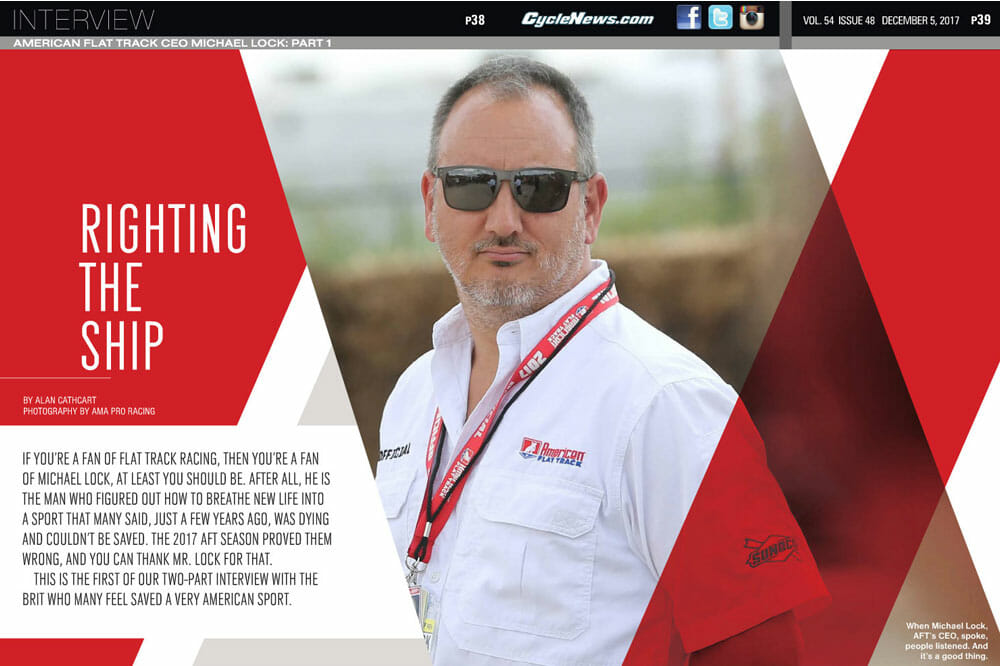
PHOTOGRAPHY BY AMA PRO RACING
But it’s undoubtedly ironic that the man responsible for transforming what was previously the best kept secret of American motor sport into an accessible, slickly staged and artfully presented spectacle should be British. Michael Lock, 52, was a passionate motorcyclist from an early age growing up in London, who went to work for Honda Britain straight out of college, initially in the Parts Department before working his way up to be one of the bright young marketeers in Honda Europe. That brought him to the attention of John Bloor, who headhunted him in 1990 to work for his newly relaunched Triumph company in establishing a network of importers across Europe. In 1993 Lock was assigned the task of establishing Triumph America in Atlanta, which he ran for three years on a 24/7 basis before suffering corporate burnout, and resigning to recharge his batteries by taking an MBA degree at Cardiff University. He was then hired as CEO of Ducati UK, a key export market for the Italian company in the heyday of Carl Fogarty. However, he lasted just 90 days there before he was summoned to Bologna to offer advice on how to rescue the car crash that Ducati’s North American operation had become, which resulted in his moving back to the USA, this time to California to head up DNA. He stayed there as CEO for the next decade, building numbers until this became Ducati’s number-one market globally, in the course of which he inevitably became involved in the company’s superbike road race program. He left in 2010 to go to Norway to work with Ford’s electric satellite Think Auto, after which he returned to the USA to run Lamborghini USA—by then coincidentally Ducati’s nominal owner within the VW-Audi group. In 2015 he joined NASCAR’s motorcycle subsidiary AMA Pro Racing—but let’s hear from him how that came about.
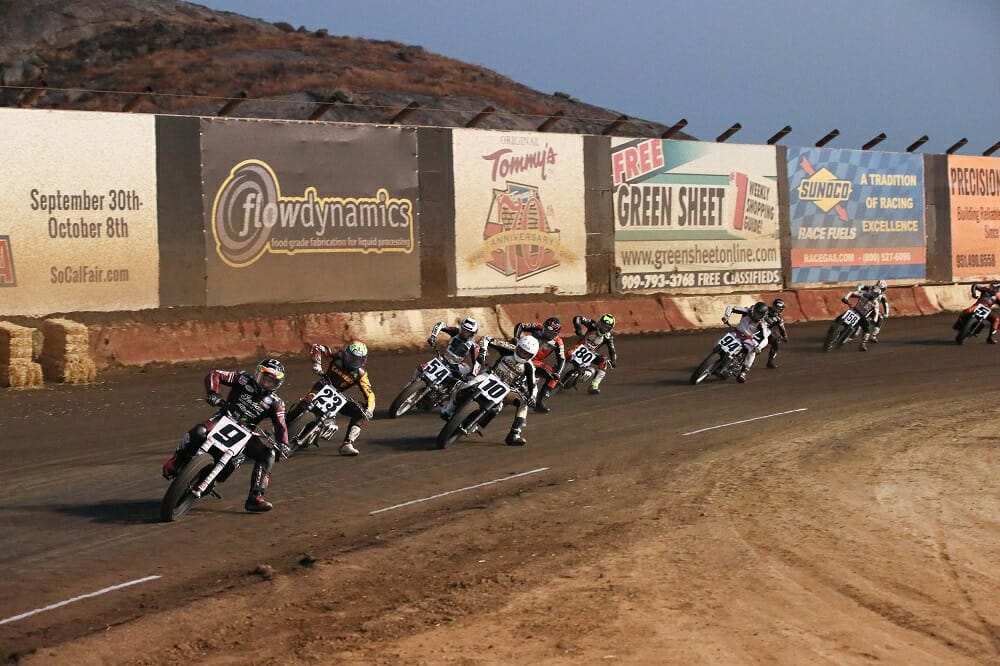 Lock understood that flat track racing was already great—that wasn’t the problem. Marketing and flawed rules were.
Lock understood that flat track racing was already great—that wasn’t the problem. Marketing and flawed rules were.
Michael, how did a Brit end up heading the organization team for such a uniquely American branch of motorcycle sport as flat track?
Three years ago in 2014 I’d just left Lamborghini USA, and was considering my options, as they say, when I got a phone call from Jim France. His father Bill France Senior was the founder of NASCAR, and Jim and his late elder brother, Bill Junior, were responsible for turning NASCAR from a regional sport into the national powerhouse it’s become. Jim is the smart silent type, so he stays out of the public eye, but he’s been every bit as much responsible for what NASCAR has become as anyone else in the France family. Additionally, though, he has a real passion for motorcycles, particularly European ones. I’d met him when I attended the Daytona 200 after just arriving in the USA back in the mid-‘90s to do the research prior to launching Triumph here, and he’d talked about the ’60s Bonneville he had, about coming back from the Vietnam war and readjusting to being in America, and how riding his motorcycle had given him a sense of grounding. We had this long chat together and got on very well, and so we stayed in touch down the years.
So in 2014 Jim France called me to say that he was reorganizing flat track racing. The France family essentially owns AMA Pro Racing, which is the body that sanctions all Pro Motorcycle Racing in the USA. They were then in the process of licensing road racing to Wayne Rainey’s outfit, and they had a long term contract for supercross with someone else, so now they were looking at flat track, and this, in fact, is Jim’s first love—indeed, he used to race himself, and I have his Bultaco in my office! He was an amateur flat-tracker back in the ’70s, and I think that like a lot of flat track racers, he’d got bitten by the bug for life. And so here he had direct control of his main interest in motorcycle racing, and he was looking at why it wasn’t working properly, what to do, what the possibilities were, where investment was needed, and so on. So he said, “Please, would you consult for me, and come down to Daytona for a couple of weeks, meet the team, get to know the sport, and tell me what we should be doing.”
 Lock and seven-time GNC Champion Chris Carr, AFT’s Chief Competition Officer (CCO), have proved to be a productive combination.
Lock and seven-time GNC Champion Chris Carr, AFT’s Chief Competition Officer (CCO), have proved to be a productive combination.
So I flew down to Daytona and I shadowed the team, I spoke to riders, team owners, media, fans, and just got to really immerse myself in the sport. But to look at it from a business development point of view, what the hell do you do? Is this destined to be forever in the shadows? Why have the golden days gone, and what were the causes for it? What do we do with the sport? And it became clear very quickly that the actual flag-to-flag racing was as good as there is anywhere in the world. Unlike most other sports you’re almost guaranteed close heart in the mouth racing every single race. And the choreography of the racing in flat track is amazing, the way they come off the straight at full pelt, and moderate their speed through the corners by turning the bike sideways and backing into the turns. And then of course all the stories come back to you about the golden age of the American racers in the ’70s and ’80s, and how they were all flat trackers—Kenny and Wayne and Eddie and Freddie, and how they dominated globally for a decade and a half on road race bikes until the electronics took over. But I also saw that this branch of racing, in its contemporary form, while very competitive, was also kind of hokey.
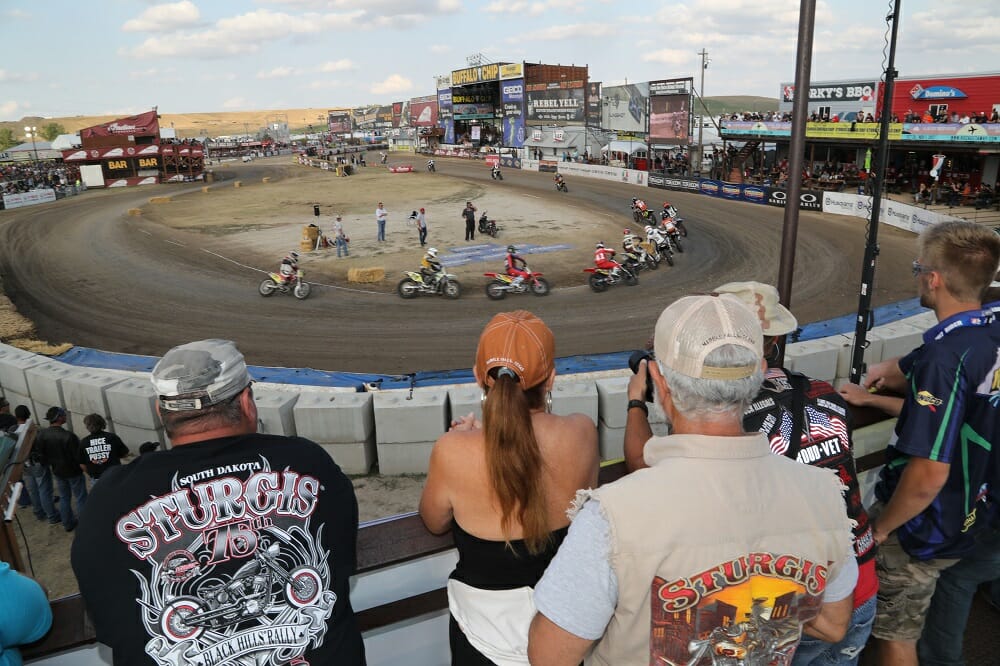 Lock wants to make being at the races a better experience for the fans.
Lock wants to make being at the races a better experience for the fans.
And underpromoted?
Oh, not promoted at all. In fact, worse than that, through the kind of organic growth of the sport in the ’90s and the 2000s when there was no money, the diehard enthusiasts took over who had a lot of time on their hands to make myopic rulebooks, and “Don’t you remember, we did that in ’87?” That meant it became a hobbyist sport; I’m not critical of that, because it kept the sport alive ready for it to be reinvented, but it’s an observation. But what this meant was that for the general public, or for any average motorcyclist who I knew would love the sport, there were too many barriers in the way. So we had two classes of racing, experts and pros. Which would be the premier one there, do you think? You could guess, and you might even get it right. Then you’d go to a race and you’d work out that the pros were really the top guys and the experts were the guys who’d like to be pros. So you’d expect to see the top class racing on the most powerful big twin-cylinder machines, and they did—except at all the rounds where they didn’t, when they rode 450 singles instead. So you say, “Okay, so in the junior class they race the 450 singles, right?” Well, yes they do—except all the rounds where they race the twins!
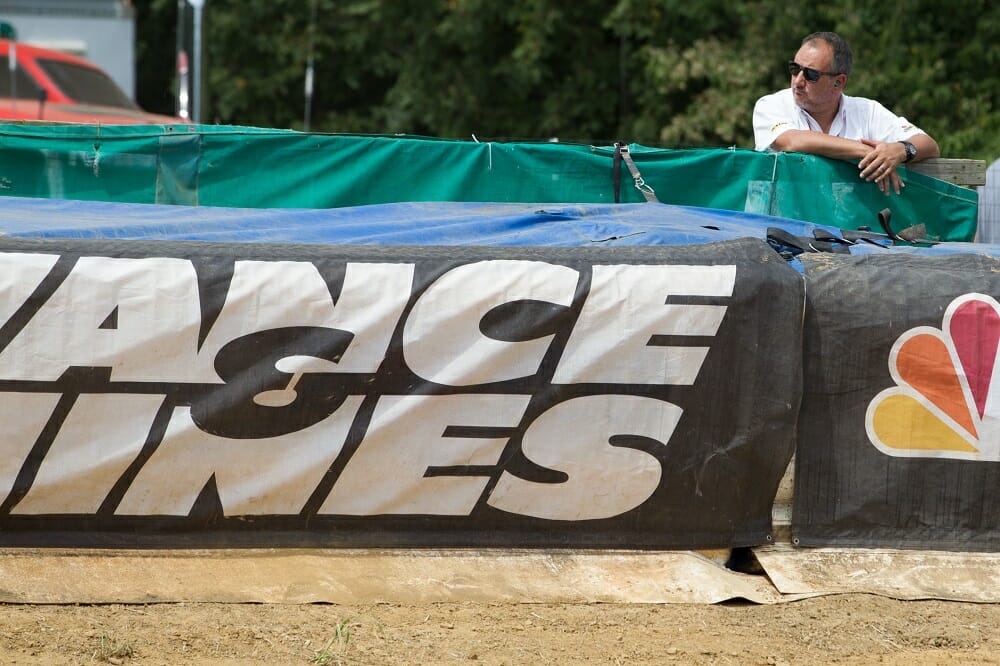 Lock’s connection with NASCAR played a valuable role in the success of this year’s AFT season.
Lock’s connection with NASCAR played a valuable role in the success of this year’s AFT season.
So looking in from the outside, I would sit in the grandstand and have the fan experience, and say, “I have no idea what’s going on here.” And you know what, I came here today to see the Harley XR750, and all I’m seeing is Honda CR singles in both classes. I feel robbed, I feel cheated. So I knew that what we had to do was to peel back all this stuff that had accumulated over the past 20 years and more, and replace it with simplicity and accessibility without losing the spectacle. We had to refine it down to two quite distinct and separate classes—a big class and a little class, a big money class and an aspiring class. Big-time racers race on big bikes, kids race on little bikes and one day they’ll race on big bikes, just not yet. So then the flak started: “Oh, you can’t do that!” “What do you mean—it’s the most logical thing of all.” “Well, you can’t race the twins on the short tracks and the TTs.” I said, “Hold on, I’m looking at old YouTube videos of Bubba Shobert doing exactly that in 1986!” “Well, that was a long time ago.” “Yes, when the bikes were heavier and the brakes were worse, and the suspension was lousy. Now we’ve got these beautiful machines, who’s telling me we can’t do that.” Okay, so now it’s “Well, then you can’t race the little bikes on the miles.” “Why not?” “Well, they’ll all blow up!” “Really, those badly engineered 450cc dirt bikes from Japan and Austria that have been fine-tuned over the last few decades….really, they’ll all blow up?”
Okay, so we had to go through a kind of cathartic exercise of slaying dragons, simplifying the sport, and engineering new relationships with the promoters to get them to understand that being a promoter wasn’t just producing a poster and selling tickets. The promoter must be telling the public “This is the hottest thing in town this weekend, and you’ve got to be there.” And it’s more than the racing, it’s the family zones, it’s the kids play areas, it’s craft beer and real food that you would actually want to eat, and well-lit parking lots, and and and and. None of it’s rocket science, it just really wasn’t yet there in flat track. Now it is.
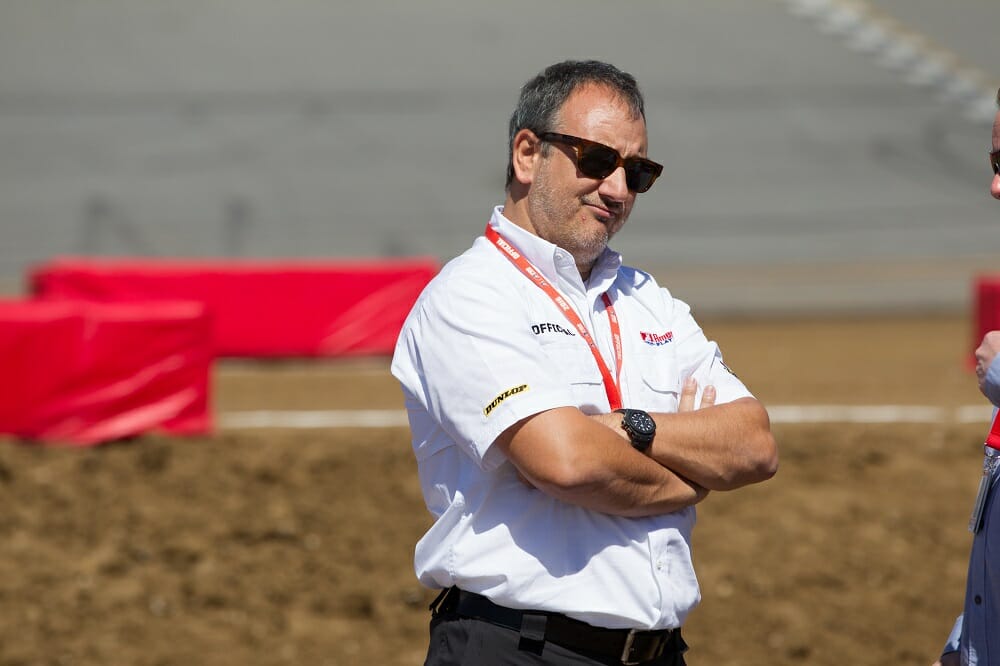
Did it need someone from outside the entire sport to come and tell them this?
I think it needed somebody from outside the sport who had sufficient related experience in the motorcycle industry that he wouldn’t be seen as an MBA suit. Because that’s the other danger, if somebody comes into a proud old sport and says, “Guys, you’ve been doing it all wrong—look, look at this pie chart.” That won’t be taken seriously; it’s true. So I think I was perceived as having an understanding through my involvement in superbike racing and through working with motorcycle dealerships, and through product development, and knowing OEMs and knowing how to raise money, etc. I was able to put my hand up and say, “Guys, it’s worth listening to me for five minutes!”
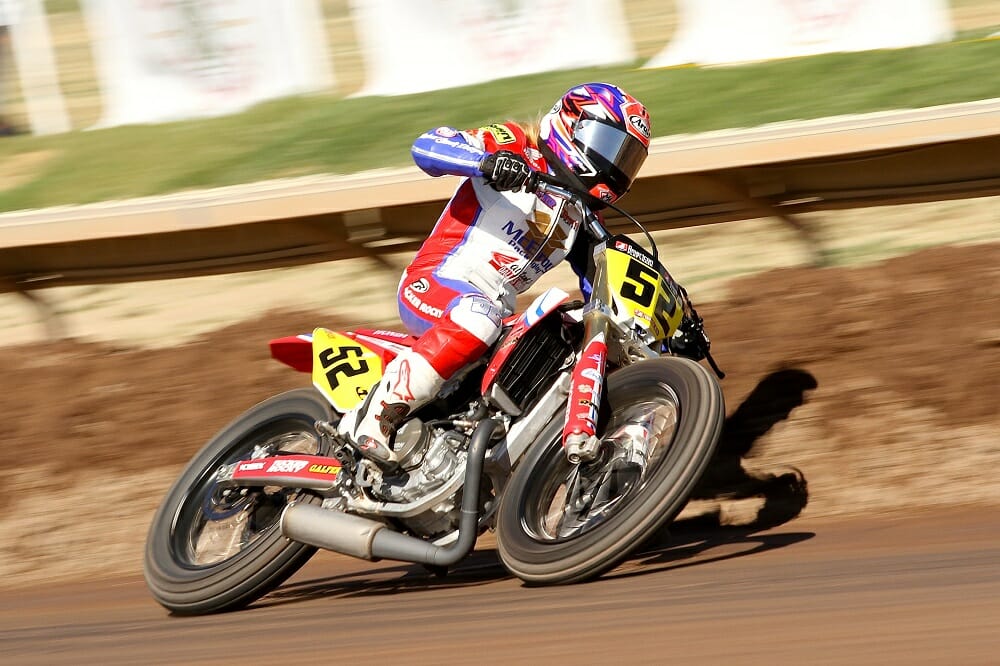 Thanks to Shayna Texter, Lock hopes that more women will be inspired to race.
Thanks to Shayna Texter, Lock hopes that more women will be inspired to race.
So when did you actually take over the restructuring of AFT?
I consulted throughout that first season, 2015, and then I presented a strategic five-year plan to the Board of AMA Pro Racing, of which Jim France is chairman, with some quite wide-ranging recommendations for change. We spent a whole day discussing these, and at the end they were very happy, and energetic about the prospect. Jim asked me if I would come on board as CEO of AMA Pro Racing to supervise this project, which I accepted to do. So 2016 was really the first season of starting to get to grips with it, and 2017 has been our true debut season where we’ve perfected a number of changes, including the re-branding. The sport was previously called AMA Pro Flat Track. Okay, there’s nothing inherently wrong with that, but it’s a bit of a mouthful, and there’s this inherent confusion. “So you guys are the AMA?” “No, no, we’re not the AMA.” “But you’re AMA Racing?” “Yes we are, so?” “But isn’t there another AMA Racing?” “Yes there is. They sanction all amateur sport, we sanction all Pro Sport. ” “So you’re not the AMA? I’m totally confused!” So what we needed to do is that old cliché of “it does what it says on the tin.” So we renamed it American Flat Track, brought to you by AMA Pro Racing—you know, like Cadillac is brought to you by General Motors.
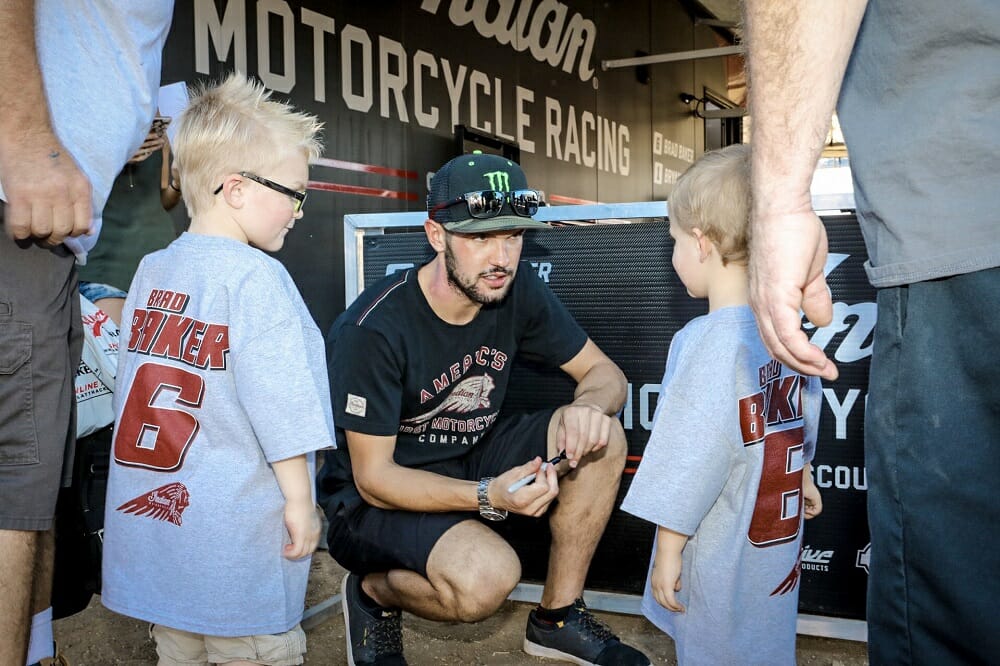 These Brad Baker fans might be future factory Indian racers. Many famous racers got their start racing flat track.
These Brad Baker fans might be future factory Indian racers. Many famous racers got their start racing flat track.
This re-branding happened in 2017?
Correct. And the class structure changed as well—two championships, twins and singles.
Right, so in the previous two years, you laid the foundations for what you’ve done this past season in essentially reinventing track racing at a national level. Did you predicate all of this in the knowledge that Indian was going to be coming in to take on Harley-Davidson, once again, for the first time in 60 years?
It was a little bit of a chicken-and-egg situation, because we’d heard through the grapevine that Polaris through Indian were interested in flat track as a way of taking their competition with Harley-Davidson to a direct level. So I reached out and spoke to the people at Indian—some of them had been at Triumph while I was there! And they confirmed, yes, they were interested, so I basically took my Board presentation to them and said, “This is what the future looks like.” And they said, “If you do that, if you separate the classes so that guys ride on twins every race, we’re in, because we don’t want to fall into the same trap Harley did the previous year, where Jared Mees won the Championship riding a Honda 450 alongside an XR750, and Harley-Davidson didn’t even turn up to the awards ceremony, because he’d just won it on a Honda. And I said, “This is madness.” So Indian also saw that, and said, “If you change the class structure so that we can set up a factory team, and we can do it properly, and we can have ‘x’, ‘y’, ‘z’ rider, every week on an Indian, we’re in!” So there was a little chicken and egg, but you’re right to say that a major catalyst for the attention we’ve had has been the return of Indian and the whole new narrative, which takes us right back to 1952. That did us no harm at all, and there was a cascade effect, because the re-branding and the new class structure, which enabled Indian to come in, also provoked Harley to step up their commitment to the sport.
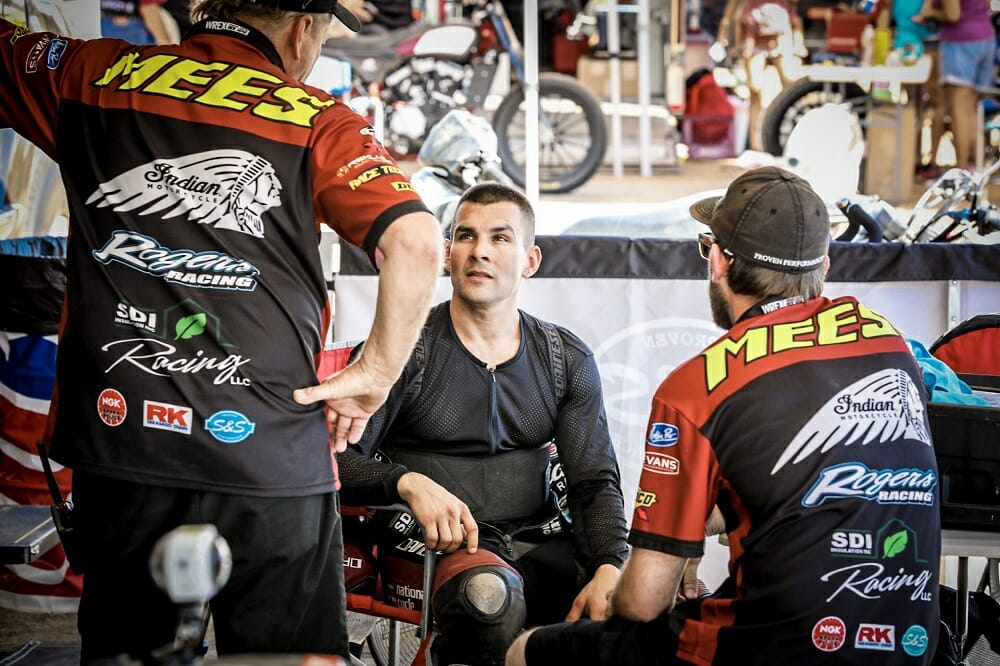 Jared Mees, the 2017 AFT Champion, has been a great ambassador for the sport of flat track racing.
Jared Mees, the 2017 AFT Champion, has been a great ambassador for the sport of flat track racing.
Quite apart from the fact that you were also satisfying Harley’s objections by not having Jared Mees win the title on a Honda when he was in Harley’s factory team?
Absolutely! The by-product was that we satisfied all the dirt bike manufacturers by now having a dedicated singles class for their bikes. So everybody came out ahead—we should have done it decades ago. So, you change the class structure so Indian comes in, so Harley says, “Right, we’re going to bite back.” That creates an American narrative that goes beyond the motorcycle business, it goes to the heartland, it goes to the culture, at which point I can dial NBC and they take my call. Or ESPN, or Fox….
Continued next week.CN